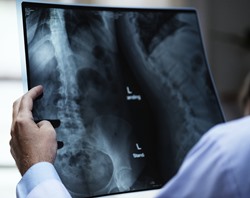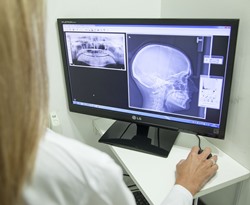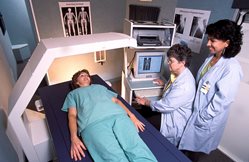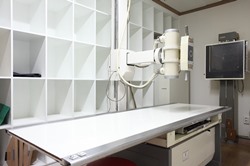How to Enroll in the Right Radiologic Tech School near Twin Valley Minnesota
 So you have decided to enroll in an X-ray tech school near Twin Valley MN in order to learn to be a radiologic technician. And now that you have made a decision to go into the rewarding field of healthcare, exactly how do you tackle selecting the right college and program to ensure that you will receive the appropriate training to become a skilled professional? And since most states do mandate that radiology techs become licensed, based on where you ultimately work you might require preparation to pass a licensing exam. So it’s important that you assess each of the X-ray technician schools you are looking at so that you can compare each program. A number of prospective students start by searching for colleges or technical schools that are within driving distance of their residences. Next, they check tuition and often gravitate toward the most affordable cost. But while location and cost should be taken into consideration, there are additional critical qualifiers also. For instance, you need to find out whether or not the radiology tech schools are accredited, or if they offer internships. These questions and others you should ask the X-ray Tech schools you are evaluating are presented later in this article. But first, let’s explore what a radiology technician does and the degrees and education choices that are available.
So you have decided to enroll in an X-ray tech school near Twin Valley MN in order to learn to be a radiologic technician. And now that you have made a decision to go into the rewarding field of healthcare, exactly how do you tackle selecting the right college and program to ensure that you will receive the appropriate training to become a skilled professional? And since most states do mandate that radiology techs become licensed, based on where you ultimately work you might require preparation to pass a licensing exam. So it’s important that you assess each of the X-ray technician schools you are looking at so that you can compare each program. A number of prospective students start by searching for colleges or technical schools that are within driving distance of their residences. Next, they check tuition and often gravitate toward the most affordable cost. But while location and cost should be taken into consideration, there are additional critical qualifiers also. For instance, you need to find out whether or not the radiology tech schools are accredited, or if they offer internships. These questions and others you should ask the X-ray Tech schools you are evaluating are presented later in this article. But first, let’s explore what a radiology technician does and the degrees and education choices that are available.
X-Ray Technician Career Summary in Twin Valley MN
 There are a number of professional designations for x-ray techs (technologists or technicians). They may also be called radiologic technicians or technologists, radiology technicians or radiographers. Regardless of the name, each has the identical major job function, which is to use imaging machines to internally visualize patients for the purpose of diagnosis and treatment. A number of radiologic technologists might also administer radiation therapy for treating cancer. Many elect to perform as generalists, while there are those that have chosen a specialization, such as mammography. They may practice in Twin Valley MN clinics, hospitals, private practices or outpatient diagnostic imaging centers. The imaging technologies that an X-Ray technician may utilize include:
There are a number of professional designations for x-ray techs (technologists or technicians). They may also be called radiologic technicians or technologists, radiology technicians or radiographers. Regardless of the name, each has the identical major job function, which is to use imaging machines to internally visualize patients for the purpose of diagnosis and treatment. A number of radiologic technologists might also administer radiation therapy for treating cancer. Many elect to perform as generalists, while there are those that have chosen a specialization, such as mammography. They may practice in Twin Valley MN clinics, hospitals, private practices or outpatient diagnostic imaging centers. The imaging technologies that an X-Ray technician may utilize include:
- Traditional and specialized X-Rays
- Computerized tomography (CT) or “CAT” scans
- Magnetic resonance imaging (MRI)
- Sonography or ultrasound
- Fluoroscopy
Radiographers must care for their equipment and also routinely analyze its functionality and safety. They are additionally expected to retain complete records of each of their diagnostic procedures. As health practitioners, they must adhere to a code of conduct and a high professional standard.
Click Here For Free Information on X-Ray Tech Schools Near You!
X-Ray Tech Degrees near Twin Valley MN
 The primary requirement for enrolling in a radiology tech college is to have attained a high school diploma or equivalent. Radiologic technologist students have the opportunity to earn either an Associate Degree or a Bachelor’s Degree. An Associate Degree, which is the most typical among technicians, generally requires 18 months to two years to complete depending on the program and course load. A Bachelor’s Degree will take more time at up to 4 years to finish and is more comprehensive in scope. The majority of students choose a degree major in Radiography, but there are other similar majors that are acceptable also. One thing to bear in mind is that radiographer schools have a clinical training or lab component as part of their course of study. It may often be fulfilled by taking part in an externship program which a large number of colleges sponsor through local clinics and hospitals in Twin Valley MN or their area. After you have graduated from any of the degree programs, you will need to comply with any certification or licensing requirements in Minnesota or the state you will be working as applicable.
The primary requirement for enrolling in a radiology tech college is to have attained a high school diploma or equivalent. Radiologic technologist students have the opportunity to earn either an Associate Degree or a Bachelor’s Degree. An Associate Degree, which is the most typical among technicians, generally requires 18 months to two years to complete depending on the program and course load. A Bachelor’s Degree will take more time at up to 4 years to finish and is more comprehensive in scope. The majority of students choose a degree major in Radiography, but there are other similar majors that are acceptable also. One thing to bear in mind is that radiographer schools have a clinical training or lab component as part of their course of study. It may often be fulfilled by taking part in an externship program which a large number of colleges sponsor through local clinics and hospitals in Twin Valley MN or their area. After you have graduated from any of the degree programs, you will need to comply with any certification or licensing requirements in Minnesota or the state you will be working as applicable.
X-Ray Tech Licensing and Certification
When you have graduated from an X-Ray tech school, based on the state where you will be practicing you may have to become licensed. Most states do mandate licensing, and their requirements differ so contact your state. Presently, all states that do require licensing will recognize The American Registry of Radiologic Technologists (ARRT) certification exam for the licensing application, but several accept additional alternatives for testing as well. Several states also require certification as part of the licensing process, otherwise it is optional. However, many Twin Valley area employers will only hire radiology techs that have earned certification so it may improve your career options in and around Twin Valley MN to earn certification. ARRT’s certification program requires graduation from an accepted program in addition to a passing score on their rigorous exam. ARRT also requires re-certification every two years, which can be fulfilled with 24 credits of continuing ed, or by passing an exam.
Online X-Ray Technologist Degrees
 As a component of any degree program, x-ray tech colleges will have clinical or lab training included in their curriculum. This is no different for online degree colleges. So although you can still obtain your degree online, a large portion of the training will be fulfilled either in a college lab or in an internship off-campus. Practical training is often provided in Twin Valley MN hospitals, outpatient clinics or private practices in sponsorship with the colleges. But the online section of the training can be attended in the privacy of your Twin Valley home. Students who keep working while earning their degree often find that the online style of education is far more practical with their active schedules. Plus online colleges are generally more affordable than traditional alternatives. Along with lower tuition, expenditures for study materials and commuting can be decreased as well. But just confirm that the online college you choose is accredited (more on the benefits of accreditation later). So if you are dedicated enough to learn with this less formalized style of training, then an online school may be the ideal choice for you.
As a component of any degree program, x-ray tech colleges will have clinical or lab training included in their curriculum. This is no different for online degree colleges. So although you can still obtain your degree online, a large portion of the training will be fulfilled either in a college lab or in an internship off-campus. Practical training is often provided in Twin Valley MN hospitals, outpatient clinics or private practices in sponsorship with the colleges. But the online section of the training can be attended in the privacy of your Twin Valley home. Students who keep working while earning their degree often find that the online style of education is far more practical with their active schedules. Plus online colleges are generally more affordable than traditional alternatives. Along with lower tuition, expenditures for study materials and commuting can be decreased as well. But just confirm that the online college you choose is accredited (more on the benefits of accreditation later). So if you are dedicated enough to learn with this less formalized style of training, then an online school may be the ideal choice for you.
Points to Ask X Ray Tech Schools
After you have chosen the kind of degree that you want to earn, you can initiate the process of searching for and assessing x-ray tech colleges near Twin Valley MN. You will also need to determine if you want to attend online classes or drive to a local campus. If you choose the latter, then naturally the location of the college will be important. The price of tuition and supplementary expenditures will be a determining factor also. But in addition to location and cost, what more should you factor in when comparing schools? Well, you should check out if the colleges are accredited, and if they sponsor externship or internship programs. To help you uncover some of these crucial details before you make your selection, we have put together a list of questions that you must ask the programs you are assessing.
Are the Radiology Technician Schools Accredited? Most radiology technician schools have obtained some form of accreditation, whether regional or national. Nevertheless, it’s still imperative to make sure that the program and school are accredited. One of the most highly respected accrediting agencies in the field of radiology is the Joint Review Committee on Education in Radiologic Technology (JRCERT). Schools obtaining accreditation from the JRCERT have undergone a detailed examination of their instructors and educational materials. If the school is online it can also obtain accreditation from the Distance Education and Training Council, which targets online or distance education. All accrediting organizations should be recognized by the U.S. Department of Education or the Council on Higher Education Accreditation. Along with guaranteeing a quality education, accreditation will also help in getting financial aid and student loans, which are many times not available for non-accredited colleges. Accreditation might also be a pre-requisite for certification and licensing as required. And numerous Twin Valley MN employers will only hire a graduate of an accredited program for entry level positions.
Are Internships Sponsored? Ask if the radiology technician programs you are evaluating have partnerships with local hospitals or clinics for internship programs. Not only are internships an excellent means to receive practical training in a clinical setting, they are additionally a means to fulfill the clinical training requirement for the majority of programs. As a supplemental benefit, they may assist graduates and students establish professional connections in the Twin Valley MN healthcare community and assist with obtaining employment.
Is Job Placement Assistance offered? You will probably want to secure employment quickly after graduation, but finding that initial job in Twin Valley MN in a new profession can be challenging without support. Find out if the x-ray tech schools you are considering have job assistance programs and what their placement rates are. High and rapid placement rates are an excellent indication that the schools have sizable networks and great relationships with Minnesota healthcare employers. It also corroborates that their students are highly regarded and in demand.
Where is the Program Located? For a number of students, the college they decide on will need to be within commuting distance of their Twin Valley MN home. Those who have opted to attend classes online naturally will not have to concern themselves with the location of the campus. However, the availability of local internships will be of importance. One thing to bear in mind is that if you choose to enroll in a program that is out of state or perhaps out of your local area, you may be required to pay a higher tuition. State colleges usually charge higher tuitions for out of state residents. And community colleges typically charge a higher tuition for those students that don’t reside within their districts.
What Size are the Classes ? Unless you are the type of student that prefers to sit way in the back of the classroom or hide in the crowd, you will likely want a small class size. Smaller classes enable more individual participation and personalized instruction. Ask the Twin Valley MN schools you are researching what the typical teacher to student ratio is for their classrooms. If practical you may prefer to sit in on one or more classes before making your final decision. This will also give you an opportunity to converse with some of the students and instructors to get their perspectives regarding the radiology technician program as well.
Does the Program Accommodate your Schedule? And last you must confirm that the radiographer college you ultimately pick can furnish the class schedule you need. This is especially important if you choose to continue working while attending school. If you need to schedule evening or weekend classes in the Twin Valley MN area, make certain that they are available. If you can only attend part-time, check if that is an option and how many credit hours or courses you would have to enroll in. Also, learn what the protocol is for making up any classes that you may miss as a result of work, illness or family emergencies.
Radiology Tech Classes Twin Valley MN
 Choosing the best radiology tech degree program is a crucial first step toward launching a fulfilling new career providing diagnostic medical services to patients. The ideal radiologic technologist should be in good physical shape. X-Ray techs frequently stand for the majority of the workday and move and at times lift the patient to obtain the proper image. Prospects must also show a capability to pay close attention to detail and to observe the safety requirements designed to protect both the medical team and the patient. X-Ray technicians work very closely with patients, other technicians as well as the doctors and radiologists. Having social skills is a necessity in order to have a pleasant work environment and furnish the best possible care to patients. You originally came to this website due to an interest in Radiology Tech Classes and wanting more information on the topic Education Needed For Radiology Technician. However, as we have covered in this article, there are a number of questions that you should ask each program you are assessing prior to making your final decision. This is equally true whether you decide on an online program or travel to classes on-campus. By asking the appropriate questions you can evaluate and compare each college so you can narrow down your options and make your final choice. And with the proper education and your motivation to succeed, you can accomplish your goal to work as a radiographer in Twin Valley MN.
Choosing the best radiology tech degree program is a crucial first step toward launching a fulfilling new career providing diagnostic medical services to patients. The ideal radiologic technologist should be in good physical shape. X-Ray techs frequently stand for the majority of the workday and move and at times lift the patient to obtain the proper image. Prospects must also show a capability to pay close attention to detail and to observe the safety requirements designed to protect both the medical team and the patient. X-Ray technicians work very closely with patients, other technicians as well as the doctors and radiologists. Having social skills is a necessity in order to have a pleasant work environment and furnish the best possible care to patients. You originally came to this website due to an interest in Radiology Tech Classes and wanting more information on the topic Education Needed For Radiology Technician. However, as we have covered in this article, there are a number of questions that you should ask each program you are assessing prior to making your final decision. This is equally true whether you decide on an online program or travel to classes on-campus. By asking the appropriate questions you can evaluate and compare each college so you can narrow down your options and make your final choice. And with the proper education and your motivation to succeed, you can accomplish your goal to work as a radiographer in Twin Valley MN.
Other Minnesota Diagnostic Locations
Twin Valley, Minnesota
As of the census[2] of 2010, there were 821 people, 357 households, and 193 families residing in the city. The population density was 943.7 inhabitants per square mile (364.4/km2). There were 431 housing units at an average density of 495.4 per square mile (191.3/km2). The racial makeup of the city was 94.4% White, 3.2% Native American, 0.7% from other races, and 1.7% from two or more races. Hispanic or Latino of any race were 2.1% of the population.
There were 357 households of which 25.8% had children under the age of 18 living with them, 40.3% were married couples living together, 8.1% had a female householder with no husband present, 5.6% had a male householder with no wife present, and 45.9% were non-families. 43.4% of all households were made up of individuals and 28.3% had someone living alone who was 65 years of age or older. The average household size was 2.17 and the average family size was 2.96.
The median age in the city was 46.8 years. 24.2% of residents were under the age of 18; 5.2% were between the ages of 18 and 24; 18.6% were from 25 to 44; 22.4% were from 45 to 64; and 29.7% were 65 years of age or older. The gender makeup of the city was 48.5% male and 51.5% female.
